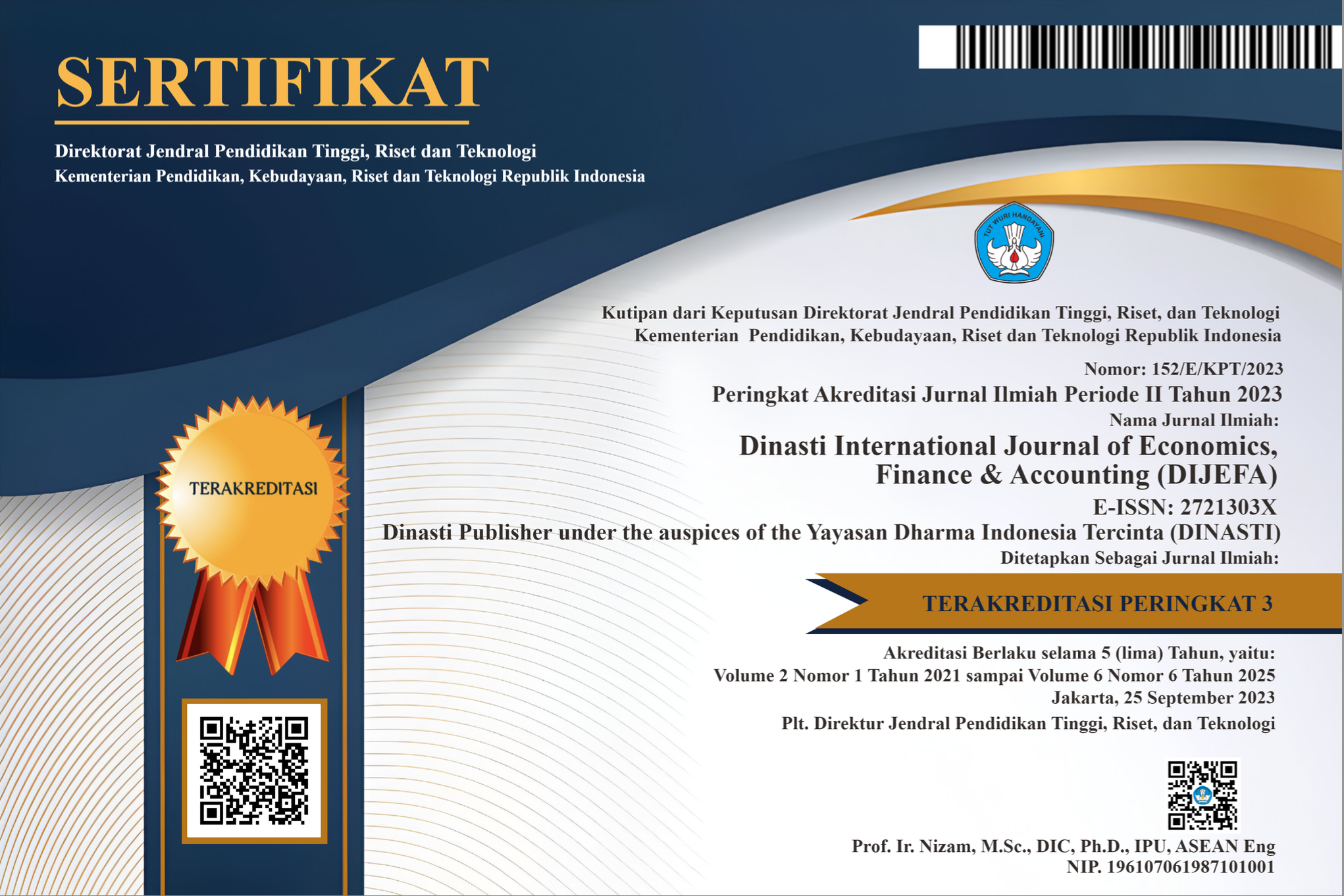The Analysis Relates to the Impact Caused by the Capital Adequacy Ratio and Loan to Deposits Ratio Which Mediated by Return on Assets Towards the Stock Prices
DOI:
https://doi.org/10.38035/dijefa.v2i2.857Keywords:
Capital adequacy ratio, loan to deposits ratio, return on assets and stock pricesAbstract
The research purpose was to discover and analyze the role of the Capital adequacy ratio and loan to deposits ratio towards Stock prices which are mediated by return on assets. The population in this research were 4 (four) state-owned banks and the sample process through purposive sampling technique with the total number of elements in the population was a sample whose subjects had met the required criteria. The research data was obtained through the publication of Financial Services Authority related to the financial statements of conventional banks and the yahoo finance website. The analysis technique used was panel data regression and data processing through Microsoft Excel 2020 and Eviews 10 applications. The results show that the Capital adequacy ratio had a positive and significant impact on stock prices, loan to deposits ratio and return on assets have no effect on stock prices. The Capital adequacy ratio had a negative and significant impact towards return on assets, loan to deposits ratio had no impact towards return on assets, return on assets is able to partially mediate the impact from Capital adequacy ratio towards stock prices and return on assets is unable to mediate the impact from loan to deposits ratio towards stock prices of state-owned banks in Indonesia during this research period.
References
Azis, M., Mintarti, S., & Nadir, M. (2015). Manajemen investasi. (ed. 1;1). Yogyakarta: Deepublish.
Butarbutar, J. (2014). Analisis pengaruh rasio keuangan terhadap harga saham melalui kinerja keuangan. Universitas Terbuka, Jakarta.
Dendawijaya, L. (2009). Manajemen perbankan. Jakarta: Ghalia Indonesia.
Eng, T. S. (2013). Pengaruh nim, bopo, ldr, npl, dan car terhadap roa bank internasional dan bank nasional go public periode 2007-2011. Jurnal Dinamika Manajemen, 1(3), 153-167.
Fordian, D. (2017). Pengaruh car, ldr, dan eps terhadap harga saham. Jurnal Bisnis Darmajaya, 3(1); 27-38.
Ghozali, I., & Subandi. (2013). Determinan efisiensi dan dampaknya terhadap kinerja profitabilitas industri perbankan di indonesia. Jurnal Keuangan dan Perbankan, 17, 123-125.
Harahap, D. A. & Hairunnisah, A. I. (2017). Pengaruh npl, ldr, gcg, nim, roa, roe, car, dan bopo terhadap harga saham pada perusahaan perbankan yang terdaftar di bursa efek indonesia dari tahun 2010-2014. Jurnal Dimensi, 6(1), 22-40.
Kasmir. (2015). Analisis laporan keuangan (ed. 1;8). Jakarta: Rajawali Pers.
Kuncoro, M & Suhardjon. (2011). Manajemen perbankan. Yogyakarta: BPFE.
Maria, Anne. (2015). Pengaruh car, bopo, nim, npl, dan ldr terhadap roa: studi kasus pada 10 bank terbaik di indonesia periode 2007-2011. Jurusan Ilmu Ekonomi Fakultas Bisnis dan Ekonomika, 4(1); 1-19.
Naftali, S. C., Saerang, I. S., & Tulung, J. E. (2018). Pengaruh tingkat kesehatan bank terhadap harga saham perbankan yang terdaftar di bursa efek indonesia periode 2012-2016. Jurnal EMBA, 6(4), 2498-2507.
Natsir, S. R. (2016). Pengaruh return on assets (roa), return on equity (roe) dan price earning ratio (per) terhadap harga saham pada perusahaan perbankan yang terdaftar di bursa efek indonesia. Universitas Islam Negeri Alauddin, Makassar.
Nurcahyanto, A. (2017). Analisis pengaruh return on asset (roa), net profit margin (npm), dan earning per share (eps) terhadap harga saham perusahaan perbankan indeks lq 45 yang terdaftar bursa efek indonesia periode 2011-2015. Universitas Muhammadiyah, Surakarta.
Puspitasari, D. (2009). Analisis pengaruh car, npl, pdn, nim, bopo, ldr, dan suku bunga sbi terhadap roa. Universitas Diponegoro, Semarang.
Prasanjaya, A. A. Y., & Ramantha, I. W. (2013). Analisis pengaruh rasio car, bopo, ldr dan ukuran perusahaan terhadap profitabilitas bank yang terdaftar di bei. E-Jurnal Akuntansi Universitas Udayana, 4(1); 230-245.
Rasyid, S. W. (2012). Analisis pengaruh ldr, nim dan efisiensi terhadap roa bank umum indonesia. Univesitas Hasanuddin, Makassar.
Riyadi, S. (2015). Banking assets and liability management. Jakarta: Lembaga Penerbit FEUI.
Sambul, S. H., Murni, S., & Tumiwa, J. R. (2016). Pengaruh kinerja keuangan perbankan terhadap harga saham yang ditawarkan di bursa efek indonesia. Jurnal Berkala Ilmiah Efisiensi, 16(2), 407-412.
Tandelilin, E. (2017). Pasar modal. Yogyakarta: PT Kanisius.
Vireyto, N., & Sulasmiyati, S. (2017). Analisis pengaruh return on asset, return on equity, dan earning per share terhadap harga saham. Jurnal Administrasi Bisnis, 5(1), 75-82.
Warsa, N. M. I. U. P., & Mustanda, I. K. (2016). Pengaruh car, ldr dan npl terhadap roa pada sektor perbankan di bursa efek indonesia. E-Journal Manajemen Unud, 5(5), 2842-2870.
Watung, R. W., & Ilat, V. (2016). Pengaruh roa, npm dan eps terhadap harga saham pada perusahaan perbankan di bursa efek indonesia periode 2011-2015. Jurnal EMBA, 4(2), 518-529.
Wibisono, A. G. (2015). Pengaruh kinerja bank terhadap harga saham pada perusahaan perbankan pemenang indonesia banking award 2013 menurut center for risk management indonesia dan tempo group. Jurnal Ekonomi Bisnis, 20(3), 194-201.
Yatiningsih, N. F. (2015). Analisis pengaruh bopo, ldr, npl, size, car, dan nim terhadap roa. Universitas Diponegoro, Semarang.
Downloads
Published
How to Cite
Issue
Section
License
Authors who publish their manuscripts in this journal agree to the following conditions:
- The copyright on each article belongs to the author(s).
- The author acknowledges that the Dinasti International Journal of Economics, Finance & Accounting (DIJEFA) has the right to be the first to publish with a Creative Commons Attribution 4.0 International license (Attribution 4.0 International (CC BY 4.0).
- Authors can submit articles separately, arrange for the non-exclusive distribution of manuscripts that have been published in this journal into other versions (e.g., sent to the author's institutional repository, publication into books, etc.), by acknowledging that the manuscript has been published for the first time in the Dinasti International Journal of Economics, Finance & Accounting (DIJEFA).


























































